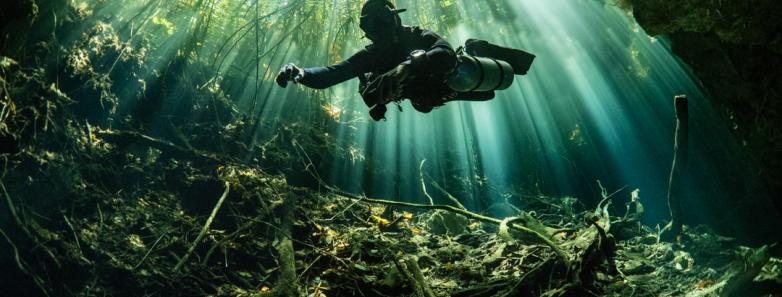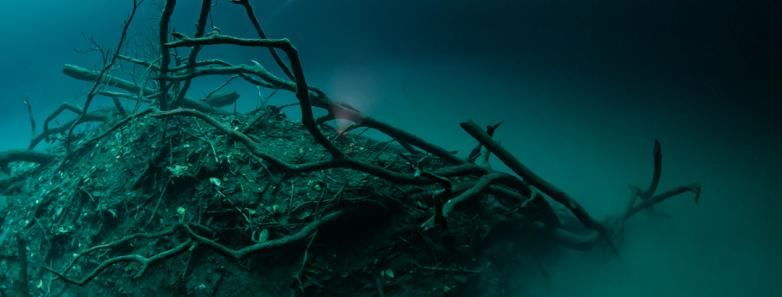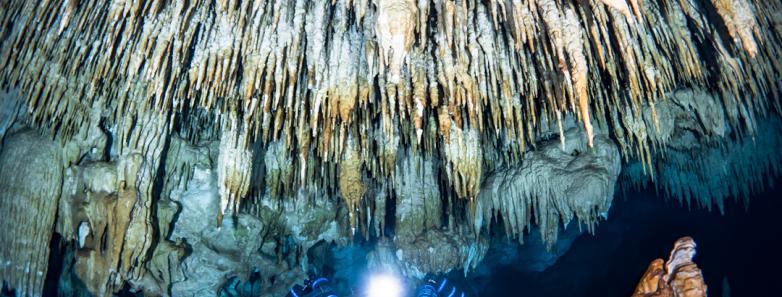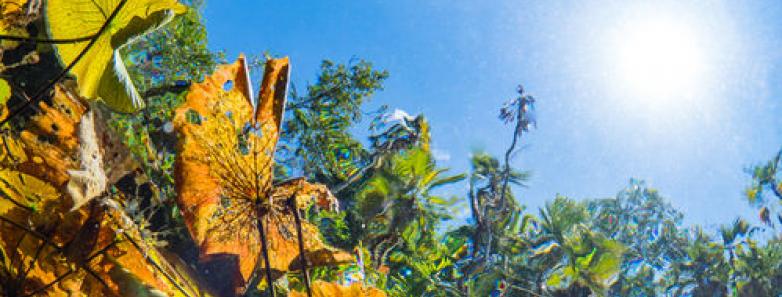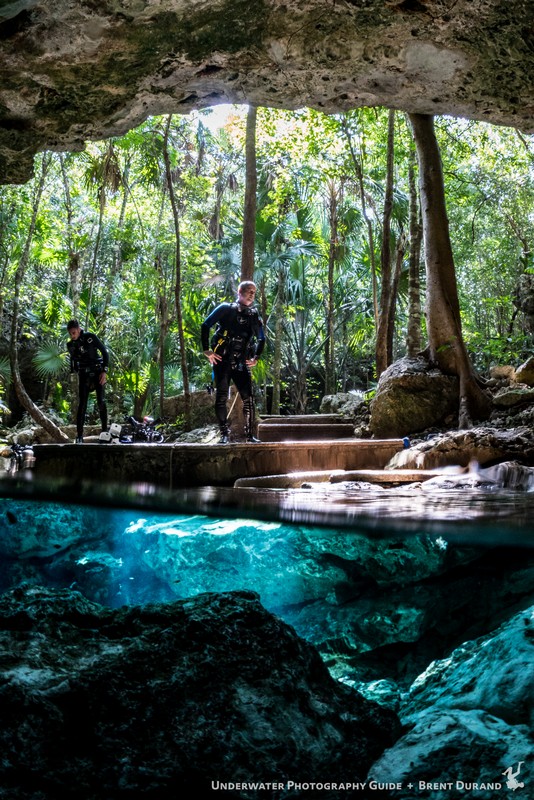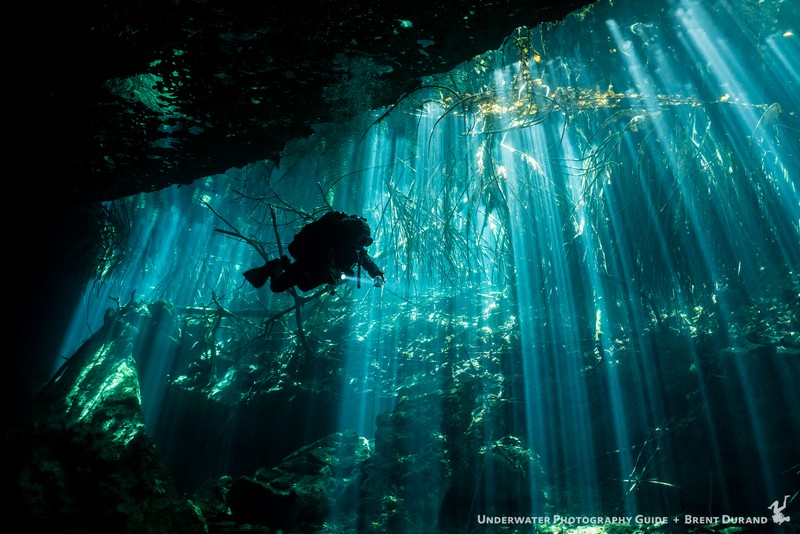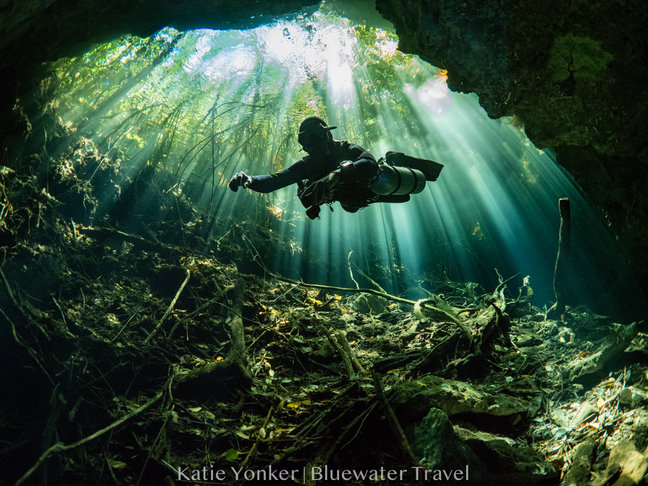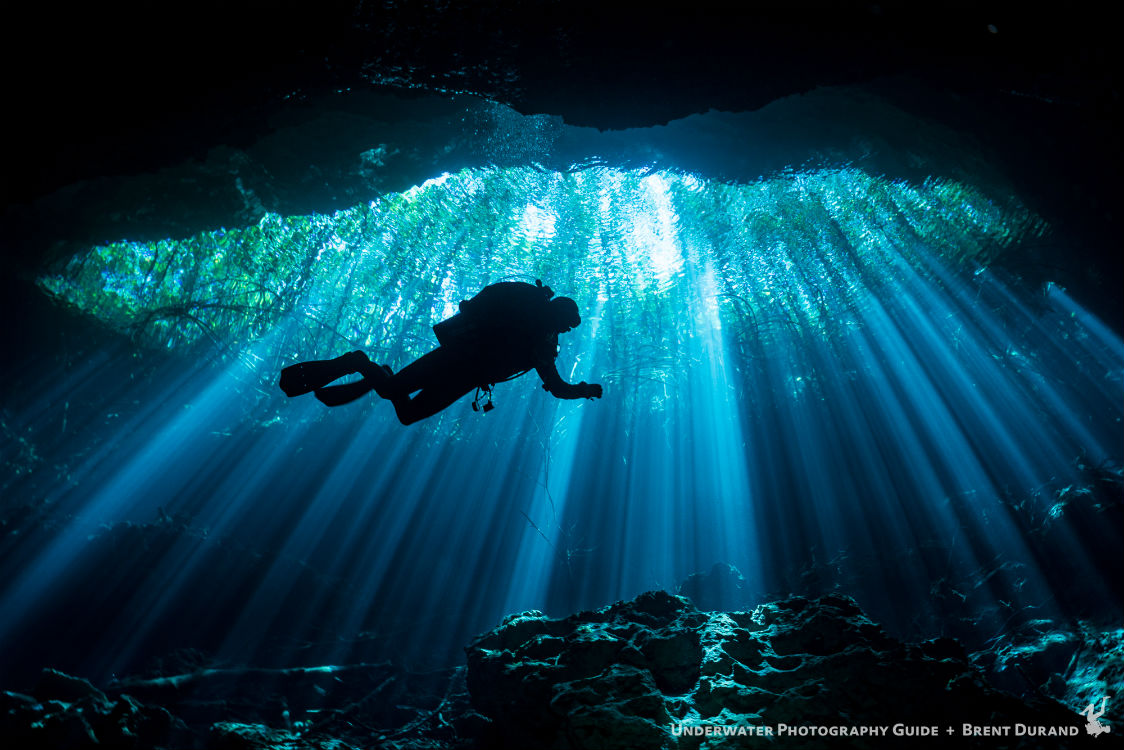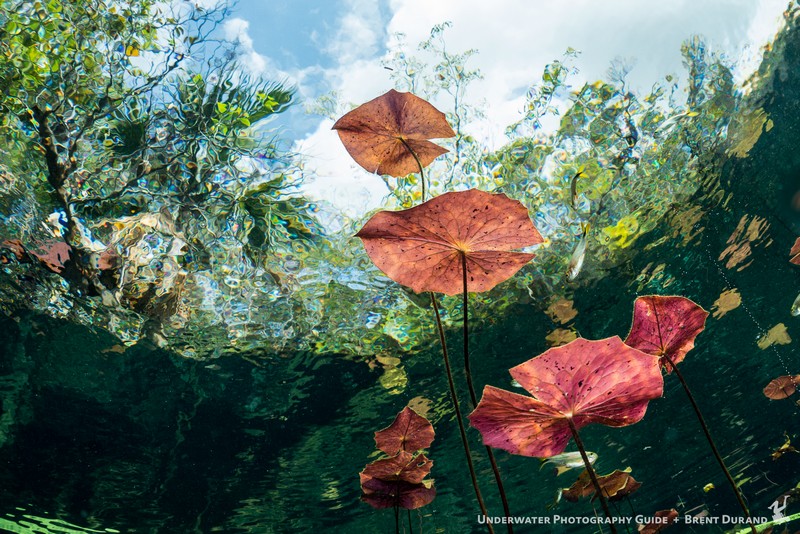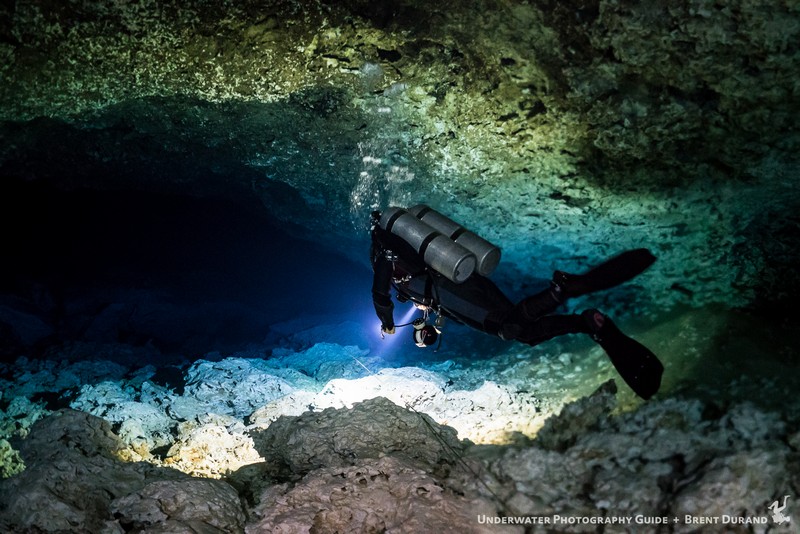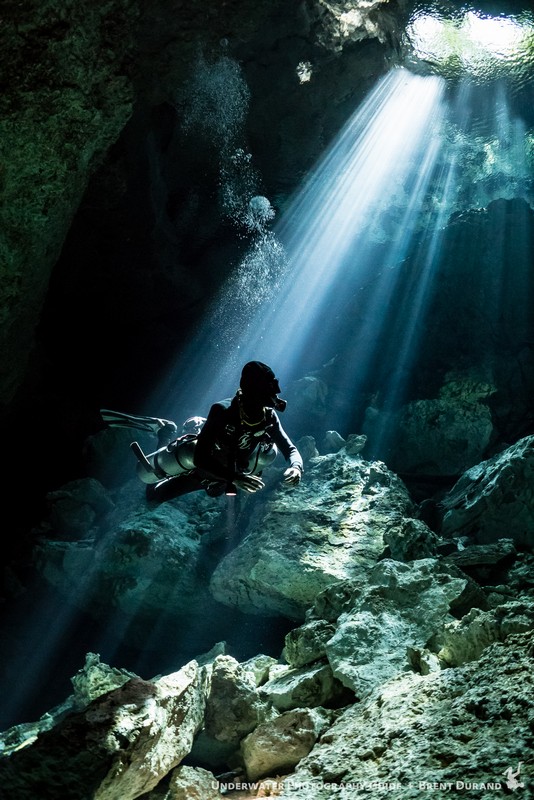SCUBA DIVING IN THE CENOTES
CENOTES DIVING HIGHLIGHTS
No dive trip to the Yucatan Peninsula would be complete without a day spent scuba diving the cenotes. Unlike any other dive experience on earth, these submerged limestone tunnels, caverns, and caves are a sight to behold and a mecca for cave divers around the world. Some of the most popular cenotes are accessible to snorkelers and open water divers as well as the technically trained, so anyone can experience a cenote dive.
JUMP TO:
When to dive the cenotes - Marine Life & Environment - Typical Cenote Dive - Diving Conditions
Best Cenotes for Diving - How to Get There - Book a Trip
INTRO TO THE CENOTES
The Mayans believed cenotes were the entrance to a sacred underwater world, and their revered status is understandable given the extraordinary underwater topography and ethereal light shows often encountered. Each cenote offers a different dive experience, blending magnificent stalactites and stalagmites, dark corners, crisp sun rays, and long views through the crystal clear water up to the jungle canopy above. Many cenotes have haloclines where a top layer of freshwater blends with a lower saltwater layer (yes, many of the cenotes connect with the ocean!). These haloclines are a blast to swim through.
Cenote diving caters to two types of diver: the full cave-certified technical diver exploring the true inner caves, and the ocean-certified diver experiencing the outer caverns. The difference is that of safety and experience; only appropriately trained divers have the skills required to safely venture into the deeper cenotes. For most visitors, diving the outer caverns is a rewarding experience due to the beautiful contrasts of light and shadow created by openings in the caverns’ ceilings. Although technically an overhead environment, these caverns are safe for non-cave certified divers to explore with a trained guide. For safety reasons, the diver to guide ratio is never more than 4:1, and the boundary where a cavern turns into a cave is usually marked by a large sign to prevent unqualified divers from straying too far from the exit.
Want to see some photos of the cenotes? Check out Diving the Mexico Cenotes on the Underwater Photography Guide.
WHEN TO GO
The cenotes can be dived year-round and are unaffected by adverse weather conditions or heavy rain. Even when you're not diving, there are many great things to do in Tulum, Cancun and the surrounding areas.
Looking for a place to stay? Check Mexico Dive Resorts here.
CENOTES DIVING INFORMATION
MARINE LIFE & PHOTOGRAPHY SUBJECTS
The water in the cenotes has been filtered through the surrounding limestone over hundreds of years and is almost completely devoid of any minerals or nutrients. This, in addition to a lack of light, makes for an inhospitable environment home to very little marine life.
However, the underwater topography of the cenotes is spectacular, and there are countless impressive rock formations and unique scenes to photograph. Some of the best sites are in the shallowest caverns, where shafts of light break through the jungle canopy to spotlight features in the darkness below.
Diving the Cenotes is on our list of the Best Scuba Diving in Mexico. Check out the full list here.
TYPICAL DIVE IN THE CENOTES
The most popular cenotes close to Playa del Carmen and Tulum can become busy during high season and are frequented daily by many of the local dive centers. However, access to the water is very easy, and some offer changing facilities, toilets, and even resident photographers ready to grab a picture of you underwater. Note that some cenotes charge entrance fees and camera fees, so ask us for more information when you're planning your trip so you know what to expect.
Read also our Mexico Crocodiles & Cenotes Trip Report to get a feel of how it is to dive in some of the best cenotes in Mexico.
DIVING CONDITIONS
- Water temperature: The water in the Cenotes hovers around 75 to 77oF (23 to 25oC).
- Visibility: Excellent due to the lack of particles in the water.
- Depth Range: 26 to 118ft (8 to 36m).
- Diving Difficulty: Available to snorkelers and open water divers through to technical cave divers.
top cenotes to dive
Here are some of the best cenotes for scuba diving in Riviera Maya, Yucatan Peninsula in Mexico:
1. Cenote Aktun-Ha - Better known as Car Wash, Aktun-Ha is situated 5 miles (8km) from Tulum on the road to Coba. With the water level just a few inches below ground level, divers find an easy entrance into the water. For cavern divers there are upstream and downstream dives possible, however, the upstream section with its large chestnut colored columns is the most popular route. Entering the water through tree roots and fallen branches feels like the beginning of a fairytale, guiding you into a strange world. Looking back towards the entrance it feels like being underneath the clouds due to small algae that live near the surface. The light falling through the vegetation creates an amazing light show, and the large room behind is beautifully decorated.
2. Cenote Dos Ojos - The entrance to this popular and famous cenote is situated just over half a mile (1km) south of Xel-Ha and roughly 30 miles (48km) from Playa del Carmen. A 2.5 mile (4km) long dirt road leads from the highway to the parking lot and cavern and cave entrances. The name Dos Ojos means 'two eyes' and originates from the two circular-shaped cenotes which are located very close to one and another. Dos Ojos is known for its multiple shallow dives and gives divers plenty of bottom time to enjoy this beautifully decorated system. Remember to look occasionally towards the entrance for great backlit effects. With shallow dives, crystal clear visibility, and great decoration, Dos Ojos is spectacular for both cavern and cave diving.
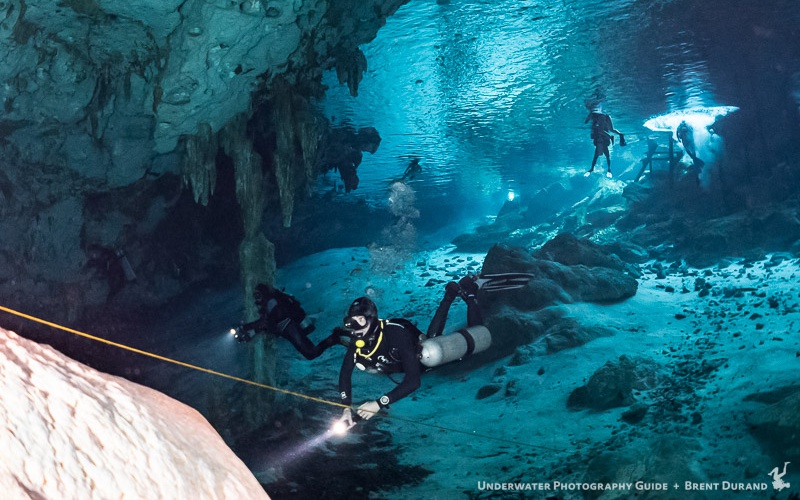
3. Cenote Calavera - Calavera, or Skull Cave, is also known as the Temple of Doom. It is located just outside Tulum on the road to Coba. Completely different from any other caverns in the area, the entrance is via a round hole in the surface rock and the adventure starts immediately with a 10ft (3m) giant stride down to water level. The cavern area is a huge room with a hill of sediment and rocks in the center. Through the course of the dive, divers wind their way slowly around the hill traveling at varying depths along the walls of the cenote. There is a good amount of light in the cavern, many hidden fossils to discover, and it is possible to move through three different halocline layers.
4. Cenote Chac-Mool - The entrance to this cenote is about 320ft (100m) south of Puerto Aventuras. There are two water entries to Chac-Mool, both leading into the same room. The first room is relatively large with lots of light entering from the cavern opening. In the second room, a portion of the ceiling has collapsed to create an air pocket where divers can surface and admire two levels of beautiful stalactites. Around the opening of the main entrance, trunks and branches reach into the water and it is here on sunny days, that a stunning laser light show takes place. With its large rooms and a maximum depth of 40ft (12m), Chac Mool is perfect for novice cavern divers. It also offers long penetration for cave divers and is home to the largest underwater stalactite in the world.
5. Gran Cenote - Gran Cenote is considered one of the best cenotes for cave diving and snorkeling in the Riviera Maya. It is part of the Sac-Aktun system, meaning ‘cave’ in Maya. It is on the highway to Coba just 2.5 miles (4km) outside the town of Tulum. Recreational divers used to be allowed to dive there, but due to its difficulty, it is now only open for full cave certified divers. The dive leads you along the edge of the circular-shaped cenote which has a maximum depth of 33ft (10m). Perfect buoyancy is required so as not to damage the highly decorated cave passages. White walls, crystal clear waters, and amazing formations await to hypnotize the diver.
6. The Pit - Labelled as a 'dream dive', The Pit is two-thirds of along the road south from Playa del Carmen to Tulum. Characterized by a shallow halocline above an ominous hydrogen sulfide cloud, this is an exciting dive into the unknown. During the descent, tree branches protrude from the mist as the cavern walls funnel you down into darkness. Above the thick layer of hydrogen sulfide, a vast cathedral-like ceiling displays a variety of stalagtites and stalagmites that break up sharp rays of sunlight disappearing into the blackness below.
7. Angelita - Located 10 miles (16km) south on the main road out of Tulum, Angelita is a uniquely picturesque cenote due to its lack of tunnels or side passages. After a 5-minute walk through the jungle, divers will discover a circular hole descending straight down to a depth of 525ft (160m). The top 100ft (30m) of freshwater give way to a band of hydrogen sulfide that gives the impression of trees reaching through the clouds. Below this, and all the way to the bottom, is saltwater and the think cloud above renders this section in almost complete darkness.
Read about other great cave diving destinations. Looking for other great diving destinations? Read about our favorite places to scuba dive.
TRAVEL INFORMATION
HOW TO GET TO THE CENOTES
Most visitors will fly internationally into Cancun International Airport (CUN), and as a popular tourist destination, there are numerous daily flights from the US and Europe. Playa del Carmen and Tulum are common hubs for diving the cenotes, with many sites only a few miles inland from these towns. Playa is only 45 minutes by bus from Cancun, and Tulum is another hour down the coast.
Other Things to Do
Discover plenty of activities nearby the cenotes, both in and out of the water. Dive the reefs of Playa del Carmen or take the ferry over to Cozumel for some of the best drift diving in the Caribbean. Visit ancient Mayan ruins, indulge in authentic Mexican cuisine, explore the shopping and nightlife scenes, and join one of many nature or adventure tours.
OTHER USEFUL INFORMATION
PRACTICAL INFORMATION
- Currency: Mexican Peso (MXN)
- Language: Spanish is the official language in Mexico but most people today learn English as a second language, especially in popular tourist spots.
- Main Airport Code: CUN
- Time Zone: UTC-5
- Electricity: 127 V 60 Hz
Got questions? Ready to book?
Call us today at +1-310-915-6677 or email us info@bluewaterdivetravel.com
And let us book your dream vacation!

